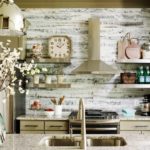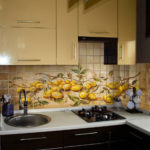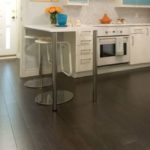Laminate kitchen apron: photo
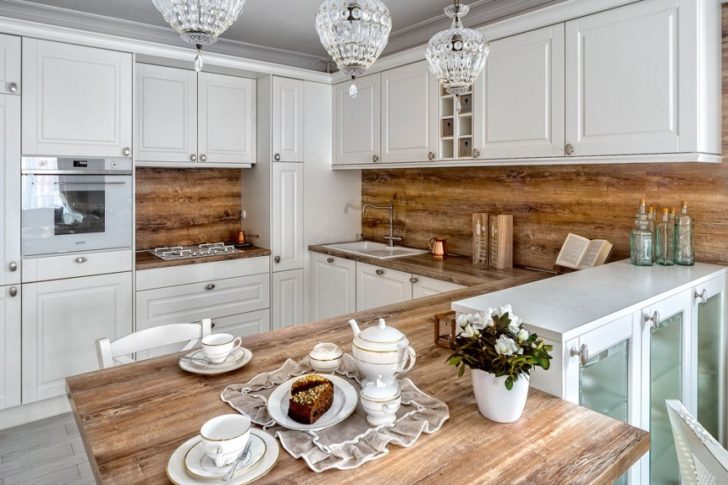 Since ancient times, people have used wood to create various interiors, but until recently, wood was not often used in the kitchen, since it is a fire hazard and has low resistance to moisture. Everything changed after the appearance of laminate on the market, which in appearance is similar to wood of any species, but does not have the disadvantages described above. Today, laminate is widely used as a backsplash design in the kitchen.
Since ancient times, people have used wood to create various interiors, but until recently, wood was not often used in the kitchen, since it is a fire hazard and has low resistance to moisture. Everything changed after the appearance of laminate on the market, which in appearance is similar to wood of any species, but does not have the disadvantages described above. Today, laminate is widely used as a backsplash design in the kitchen.
The content of the article
Laminate kitchen apron: selection criteria
If we consider such a functional element as a kitchen apron, then first of all it is necessary to proceed from considerations of practicality. Therefore, when choosing a laminate, you need to pay attention to the following criteria:
- The slabs can be of different thicknesses - the material is made from 5 mm thick. Moreover, a laminate of 7-8 mm is considered thin, more than 14 mm is considered thick. The most popular products are those with a thickness of 9 mm.
- It is advisable to purchase laminate flooring of at least class 31.
- The material chosen for the design of the kitchen apron must be moisture and wear-resistant. Not all products have these properties, so when choosing, be sure to find out about these parameters.
The width of the slabs is 85-170 mm. Moreover, the length depends on the appearance of the laminate:
- 85-170 mm - parquet imitation;
- 190-200 mm - imitation of a plank floor;
- 310 mm - imitation of tiled floor tiles.
- 410 mm - imitation of antique parquet.
Important! The laminate can be made in the shape of a square with dimensions of 395 and 625 mm.

When choosing the color scheme of the laminate for the apron, it is necessary to take into account the general style of the interior and the predominant color in the room, and it is desirable that the color of the apron matches the color of the window opening, trim or doors. It is not recommended to select products to match the tone of the floor covering.
Combination with the interior
Finishing a kitchen apron with laminate is an excellent addition to the interior of almost any style of room. However, there are some trends that determine the choice of a particular model:
- Imitation of natural wood: taking into account the shade - all styles, from classic to art deco.
- Imitation of inlaid parquet: goes well with the classic style, as well as with interiors in the spirit of baroque, country, empire, and in some cases art deco.
- Products with bright prints: avant-garde, minimalism, art nouveau.
- Material in cool tones: this laminate is best used for Gothic styles (it is advisable to choose darker tones), as well as avant-garde. Sometimes this backsplash can be made for a Renaissance kitchen.
- Imitation of antique parquet: best suited for country, classic and postmodern interiors.
Attention! For interiors designed in light shades, aprons made from a matte finish in neutral natural colors are best suited. If the room is dark, it is advisable to choose a glossy laminate in light colors.
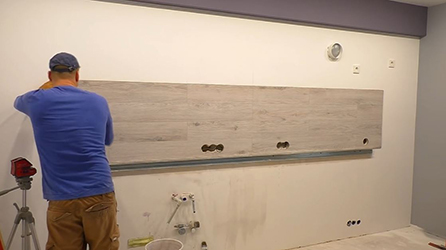
Moreover, the size of the picture, if there is one, must be proportionate to the kitchen. In other words, you should not choose laminate with a small pattern for a large kitchen.
Advantages of a laminate kitchen apron
Laminate has many advantages that make this material so popular when decorating a backsplash:
- Characterized by high resistance to moisture.
- Protects the working wall from fat, juices and other liquids.
- The apron is easy to install; you can lay the laminate yourself.
- Resistance to aggressive chemicals.
- Even after a certain time, the laminate will be able to retain its original appearance, despite constant washing, mechanical stress and ultraviolet irradiation.
- Availability of material: every specialized store has a huge assortment of laminate.
- Unlike many materials for decorating an apron in the kitchen, laminate has a relatively low price, and a small amount is required, so most often one package is enough to create an apron.
- A variety of colors and patterns makes it easy to choose the material that best suits the chosen interior of the room.
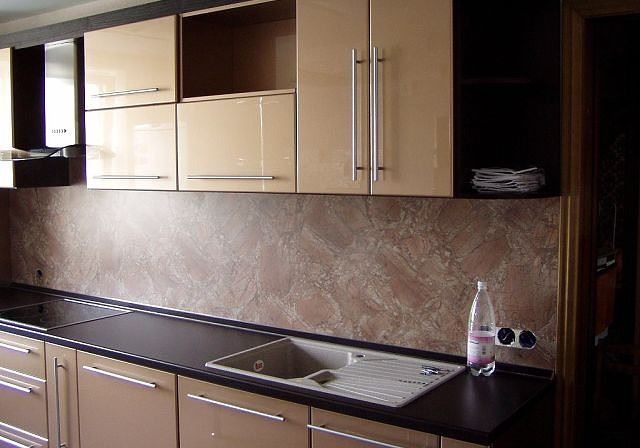
But there are also certain disadvantages:
- Despite its “natural” appearance, laminate is still an unnatural material.
- During installation, all seams must be protected so that water cannot enter the joints.
- Quite low resistance to significant temperature changes. By and large, laminate is not used during intense heating, which occurs with the wall located behind the stove. However, this flaw is very easy to fix. If you install the slab at a distance of 15 cm from the wall, then nothing will happen to the laminate.
After studying all the pros and cons, as well as seeing photos of the types of laminate, you can choose the appropriate material. Covering the surface of walls with laminate is a real improvisation.Without which you will not be able to achieve a good result when decorating an apron in the kitchen.

